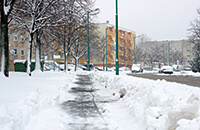Articles
Choosing the Best Deicer
Categories: Cleaning Best Practices, Cleaning for Health & Safety, Innovations, Trends & Technology
By Nate Clemmer | November 19, 2018 << Back to Articles
As the variety of deicing and anti-icing materials has increased, facility decision-makers must balance the pluses and minuses of the solutions available. Which are most effective—and most cost effective? What are the environmental impacts? How quickly and conveniently can they be applied?
Importantly, facility managers and maintenance contractors must consider how deicing materials impact surfaces and fixtures, both indoors and out. Managers are increasingly unwilling to accept stained and damaged floors and carpeting due to deicing material being tracked inside. Meanwhile, outdoors, some areas require careful attention—parking lots, sidewalks, and wheelchair ramps—while deicers’ impact on metals in light fixtures and railings as well as nearby plant life also must be considered.
Deicers’ Impact Indoors
How deicers impact carpeting and flooring is more than just an issue of appearance; some materials can cause permanent damage, increased maintenance costs, and worse, pose a health risk to occupants.
Sodium chloride—or rock salt—leaves a white residue that can dull the finish of wood floors and cause them to splinter. Carpeting exposed to sodium chloride can develop dry rot and cause color fading.
When calcium and magnesium chloride-based products are tracked into a building, they often coat floors with an oily residue that can damage wax and urethane finishes and make hard surface floors slippery, increasing the risk of injuries. If left in contact, these materials can degrade carpets by wearing out fibers and attracting dirt.
An alternative to these granular deicing materials are technology-based liquid deicers. Their neutral pH formulations eliminate tracking and reduce labor costs associated with manual cleaning. Long term, this reduces the need for full strip and recoats, which represents a significant financial savings.
Deicer’s Impact Outdoors
Users of deicing and anti-icing materials have become increasingly aware of the impacts these materials can have when applied on the outdoor surfaces. The salt residue left over from many products can cause permanent damage to pavement, asphalt, concrete, masonry, decorative stone, or other custom walkways as well as metal light fixtures and railings. And some chloride-based products can cause some form of harm to humans, animals, and plants: Sodium chloride products can cause irritation and burns to the skin and eyes and, if swallowed, to the mouth, throat, and digestive tract in both humans and animals. Contact with calcium chloride-based products can burn human skin; if inhaled, dust particles can cause irritation and if ingested, irritation, vomiting, and diarrhea. They also can irritate dogs’ paws and are poisonous to canines. When spread on to vegetation, calcium chloride products can have a defoliating effect.
Magnesium chloride-based products are considered better for the environment than products made from sodium and calcium chloride, but they cannot be considered child- and pet -friendly ice melts. All three chloride-based products are hygroscopic; absorbing moisture from the air and removing moisture from skin and vegetation. And if leached into waterways, chloride-based products also can reduce the water’s available oxygen levels, which can harm aquatic life. Formic technology deicers are 100 percent chloride free and readily biodegradable. They are can be safer for water, plants, concrete, asphalt, stone, and metals.
Pedestrian Safety
While potential property damage is critical, the primary purpose of anti-icing and deicing materials is to create a safe surface for walking. An important aspect to consider is the time required to ensure a safer walking surface. Chloride-based granular deicers may take more than five minutes to achieve an acceptable ice melt. Liquid deicers based on formic technology may remove thin layers of snow and ice factor and prevent new accumulations. Some formic technology deicers achieve a speed of melt of about 50 seconds by reducing the freezing point as low as minus 63 degrees Fahrenheit.
Cost-effectiveness
Determining the cost-effectiveness of a deicing material requires considering many factors: speed of melt, amount of product required, and the application process. Ease and speed of application combined with reduced transport and loading costs make using liquids an attractive option. Granular products can be labor intensive, slowing the application process and negatively impacting safety in high-traffic pedestrian areas. In larger areas, push spreaders are often utilized. Liquid applications can be more efficient as liquid tanks fill quickly, and spray applicators are convenient and provide precise application rates.
The low quantity of liquids required to produce an adequate melt combined with the ease and speed of application can make liquid deicers more cost-effective.
So, when deciding what kind of deicing material to use this winter, check four boxes: a safe, walkable surface outside; reduced damage inside; less outside harm; and cost-effectiveness.
About the Author.
Nate Clemmer is CEO of Branch Creek. For more information on liquid deicing, visit trulyabouttomorrow.com.





